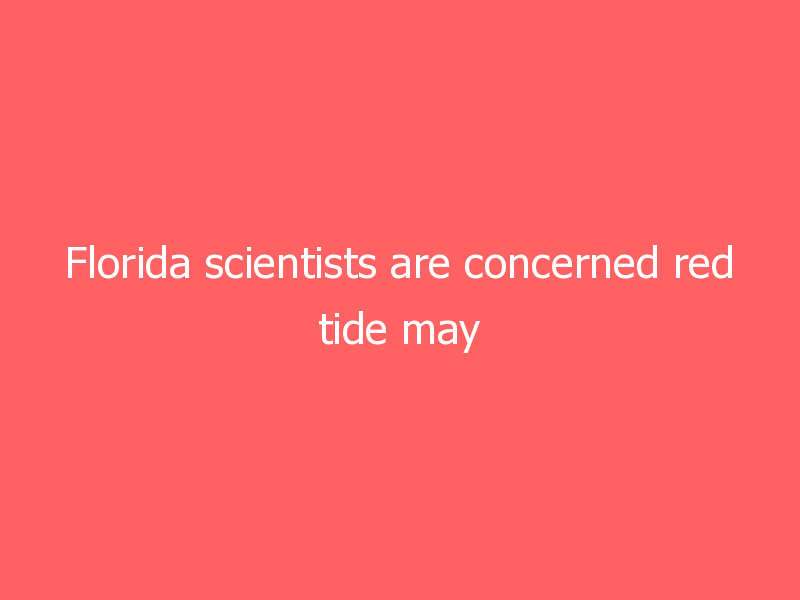SARASOTA, Fla. — When a red tide bloom gets close to the coast or even in Tampa Bay, it’s impossible to miss. It’s that infamous smell of dead fish, and if it’s bad, it can irritate your respiratory tract. But doctors don’t think it stops there. Now they’re looking at the side effects red tide might have on the human brain.
“When that last bad red tide we had, I had sort of this hacking cough, and I never really experienced that before, and it went away. And then this year, this cough has come back again. And I suspect it’s caused by living so close to the beach and being exposed to red tide.” said Sarasota resident James Powell.
It’s symptoms like that that Powell reports to the Roskamp Insitute in Sarasota as a participant in a recent study on red tide effects on the human neurological system.
Daniel Niedospial, Research Assistant, Roskamp Institute testing samples from a participant.
In its second year, the study compares people with high exposure and little-to-no exposure to red tide. They report their symptoms as well as blood and urine samples during a bloom.
“The toxin that the red tide releases are a neurotoxin; it damages the nervous system. That’s how it kills wildlife, how it kills fish, manatees, dolphins, and we know it can affect us as well,” Roskamp Institute Executive Director Dr. Michael Mullen told ABC Action News.
In the early 2000 red tide blooms, scientists conducted a 10-year study on respiratory effects, specifically asthma, but also started documenting other symptoms.
“General malaise, not feeling good, little lethargy,” explained Barb Kirkpatrick, the executive director of the Gulf of Mexico Coastal Ocean Observation System (GCOOS).
That’s when they looked into emergency room visits from 2005 to 2009 and discovered a significant uptick in neurological symptoms in zip codes on the coast.
“There was an uptick in things like a headache in particular during a red tide,” Kirkpatrick said.
“There are certain people that complain of memory and other mental faculty impairments during a bloom,” Mullen adds.
In the Roskamp lab, they’re currently looking at 250 people — comparing the level of brevetoxin in the blood and how their bodies respond.
“For instance, we can see antibodies to the toxin in the blood of certain individuals, long after the toxin is gone,” Mullen explained. “And one of the things that’s very interesting that we’ve seen already is there are quite big differences in the levels of antibody to the toxin between individuals, even when they haven’t been exposed for six months or so.”
One question they’re hoping to answer is: Are high levels of antibodies a good thing or a bad thing?
“We don’t know how that correlates with neurological complaints. Do you have fewer neurological compliance if you have high levels of antibody because the antibodies are mopping up the toxin, or does it work the other way around, and somehow the antibody causes problems? We simply don’t know at this point,” Mullen said.
The Roskamp Institute has also done extraordinary work on Alzheimer’s Disease. Mullen said long-term, he really wants to know if the red tide will affect diseases like Alzheimer’s or Parkinson’s?
“Can something like this toxin make things worse, or not. Hopefully, the answer is no, but nobody’s looked at this before,” he explains. “We really need to make sure there’s not a significant public health risk here.”
Mullen and his colleagues say that with so many people moving to Florida, specifically the coast, the answers to this study may be more important than ever.
The Roskamp Institute is looking to add about 150 more participants. They especially need people who live inland. If you’d like to participate, click here.
They are hoping to have their first set of results by 2022.
GCOOS is also trying to get research funding to look into red tide effects on the skin.
Kirkpatrick said there are reports of skin rashes from those that swim in water with high levels of red tide, but they don’t have any data sets to say how widespread or serious the exposure may be.
“We have anecdotal reports of skin rashes, swelling of the eyes and the lips, the nasal mucosa, but what we don’t have any good science on is that one in 100,000 people that get a skin rash after swimming in red tide, or is that one in 100 people?” she explained.
GCOOS also created a beach forecast website for people to look at before heading out for a beach day. It updates every three hours to let you know if there might be a better time of day when less red tide could be washing up to the shore.
Stassy Olmos at WFTS first reported this story.
Originally found on Read More







